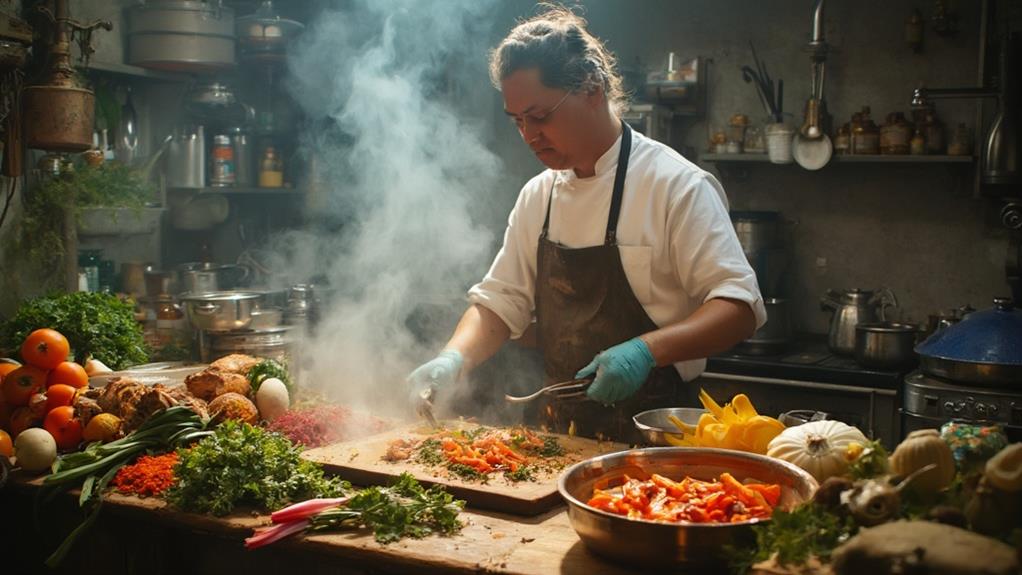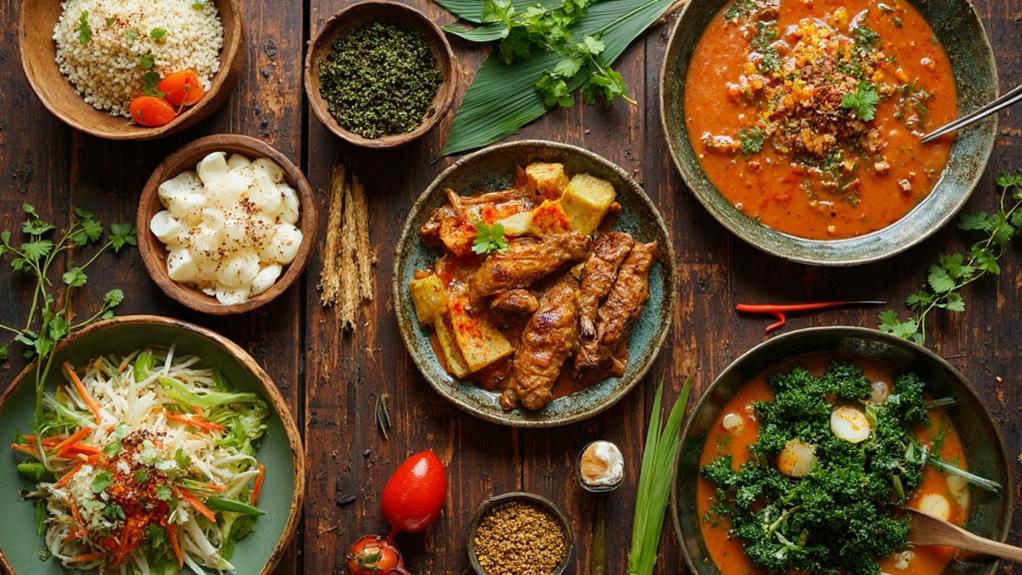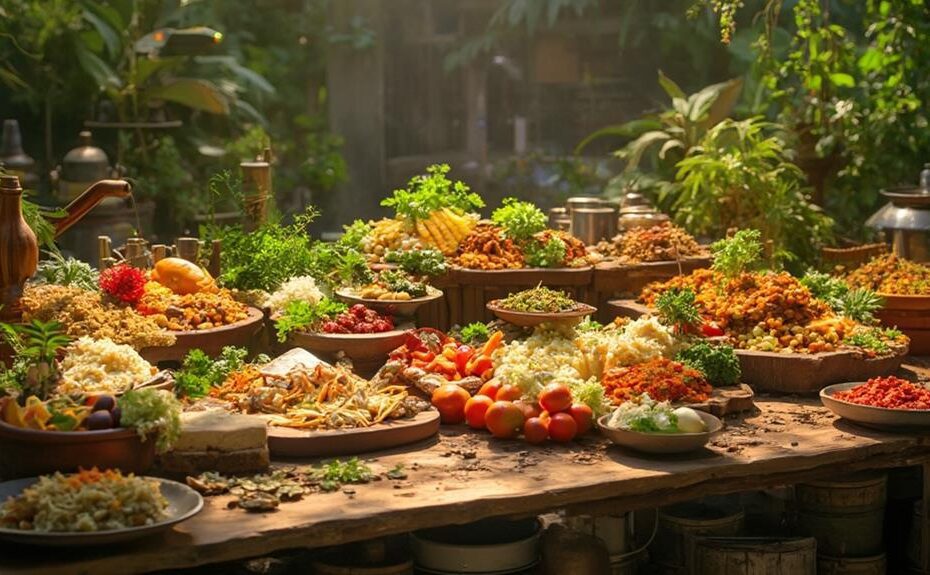The future of Filipino food lies in balancing tradition with health by incorporating nutrient-dense ingredients into classic dishes.
Adobo and sinigang can be made healthier by substituting refined grains with wholesome alternatives like brown rice and quinoa. Additionally, healthy cooking techniques such as air frying and steaming can replace traditional frying methods.
Using local produce not only enhances the flavor of dishes but also increases their nutritional value.
For example, incorporating leafy greens like pechay and kangkong into sinigang adds essential vitamins and minerals. Moreover, modern trends are shifting towards less processed options, such as using fresh tomatoes instead of tomato sauce.
Sustainable sourcing is crucial for promoting a healthier planet and supporting local communities.
Buying produce from local farmers reduces carbon footprint and boosts the local economy. By making mindful food choices, one can indulge in the bold flavors of Filipino cuisine while prioritizing health.
The Rich Heritage of Filipino Cuisine
Filipino cuisine is a unique blend of indigenous ingredients and foreign influences, resulting in a rich tapestry of flavors and traditions that reflect the country's vibrant history. Local staples like rice, vegetables, and seafood are often combined with spices and cooking techniques introduced by Spanish, Chinese, and American cultures. This culinary fusion is evident in dishes like adobo, sinigang, and lechon, which provide a unique experience that tantalizes the taste buds.
The country's textile heritage, with its vibrant cultural tapestry, also reflects this blend of influences. The fusion of indigenous craftsmanship with foreign techniques has created a unique design aesthetic.
Filipino cuisine makes use of fresh ingredients, such as tropical fruits and vegetables, which not only enhance flavor but also contribute to nutritional value. Dishes that incorporate leafy greens, like in pinakbet, deliver essential vitamins and minerals. Seafood, abundant in the archipelago, offers omega-3 fatty acids, while legumes like mung beans provide protein and fiber.
Traditional cooking methods, such as grilling and steaming, further preserve nutrients, making meals both delicious and health-conscious. By embracing this rich culinary heritage, you can enjoy a diverse array of flavors while also appreciating the nutritional benefits inherent in Filipino food.
Engaging with these dishes connects you to the past, allowing you to savor the essence of a culture steeped in history and community.
Modern Nutritional Trends
Modern nutritional trends are transforming Filipino cuisine. This shift emphasizes whole, unprocessed foods that prioritize nutrient density. Traditional dishes are being recreated to reduce unhealthy fats and sugars while maintaining their rich flavors.
For example, brown rice is replacing white rice, and coconut milk is being used sparingly to minimize calories.
The cultural significance of abaca, an integral part of Philippine heritage, inspires creative food presentation, elevating the dining experience.
Plant-based diets are gaining popularity, leading to a resurgence of vegetables like malunggay and sitaw in everyday meals. These ingredients not only boost the nutritional profile but also enhance the vibrant colors and flavors of dishes.
Fresh herbs and spices are being highlighted in recipes because they aren't only flavorful but also rich in antioxidants. The rise of mindful eating encourages savoring each bite, promoting a holistic approach to nutrition.
By focusing on portion control and balanced meals, traditional favorites like adobo or sinigang can be enjoyed while maintaining overall health.
Innovative Cooking Techniques

Innovative cooking techniques are revolutionizing the way traditional Filipino dishes are prepared and enjoyed, while also enhancing their nutritional value.
Sous-vide cooking, for instance, allows for the retention of moisture and nutrients in meats and vegetables, making dishes like adobo more flavorful while reducing the need for excessive oils or fats. This method ensures that the nutrients aren't lost during cooking, resulting in a healthier and more flavorful meal.
By adopting creative approaches to reduce waste, home cooks can minimize food waste in the kitchen.
Using steam instead of frying, for example, helps preserve the vibrant colors and essential nutrients in vegetables like sitaw (string beans) and talong (eggplant). This technique ensures that the vegetables retain their nutrients and flavors, making them a healthier option.
Fermentation is another technique that not only adds complex flavors to meals but also boosts gut health.
Incorporating fermented ingredients like bagoong (fermented shrimp paste) in moderation can enhance flavors without compromising nutrition. Fermented foods are rich in probiotics, which are essential for a healthy gut.
Air frying offers a healthier alternative to deep-frying, significantly cutting down on unhealthy fats while still providing that satisfying crunch.
Air-fried lumpiang shanghai, for instance, is a healthier version of the traditional deep-fried spring rolls. By adopting these innovative techniques, home cooks can preserve the essence of Filipino cuisine while promoting a healthier lifestyle.
How Can Filipino Cuisine Balance Tradition and Nutrition for Better Health?
Filipino cuisine celebration flavor can still be traditional and healthy. By using fresh ingredients like fruits and vegetables, reducing salt and sugar, and incorporating lean proteins, Filipino dishes can maintain their rich, savory flavors while promoting better health. It’s all about finding the balance between tradition and nutrition.
Sustainable Sourcing of Ingredients
Sustainable Sourcing Enhances Flavors and Nutrition
Sourcing ingredients sustainably not only supports local farmers but also enhances the flavors and nutritional profiles of your dishes. Fresh, locally sourced ingredients have higher nutrient content compared to those transported over long distances. This is because they're often picked at peak ripeness, delivering vibrant flavors that processed or imported options can't match.
Supporting Rural Communities and Preserving Cultural Heritage
By choosing sustainable materials, such as abaca fibers, you're supporting the growth of rural communities and contributing to the economy. Sustainable practices in agriculture, similar to those employed in abaca production, help preserve cultural heritage and promote eco-friendly practices.
Sustainable Seafood Ensures Delicious and Healthy Options
Choosing sustainably sourced seafood ensures you're consuming fish that aren't only delicious but also safe and healthy. Overfishing and unsustainable practices can lead to depleted stocks and environmental harm. By opting for responsibly farmed or wild-caught options, you're helping to preserve marine ecosystems while enjoying a rich source of omega-3 fatty acids.
Direct Relationships with Food Sources
You can explore organic farmers' markets or community-supported agriculture programs to build a direct relationship with your food sources. This connection not only enhances your cooking experience but also fosters community ties and supports local economies.
As you embrace sustainable sourcing, you'll not only elevate your meals but also contribute to a healthier planet and a more resilient food system.
Fusion of Traditional and Healthy

Combining traditional Filipino flavors with modern, healthy cooking techniques creates a culinary experience that's both delicious and nutritious.
To elevate classic dishes, incorporate nutrient-dense ingredients and cooking methods that preserve flavor while reducing unhealthy fats. For example, instead of frying lumpia, bake or air-fry them for a lighter option that still retains that satisfying crunch.
Using whole grains like brown rice or quinoa in sinangag instead of white rice provides more fiber and enhances the dish's nutritional profile.
Experimenting with vegetables like malunggay or kalabasa, which are rich in vitamins and minerals, adds an extra health boost to dishes like kare-kare.
Filipino cuisine is known for its bold flavors, and using fresh herbs like cilantro or basil can enhance taste without adding calories.
By blending traditional elements with healthier choices, you're not just preserving the essence of Filipino food but also promoting a balanced diet.
This fusion redefines comfort food, making it accessible and enjoyable for today's health-conscious diners.
Community and Cultural Impact
Filipino cuisine plays a vital role in fostering community bonding and cultural identity. When families and friends gather around a table filled with traditional dishes like adobo, sinigang, or lechon, they share stories and traditions passed down through generations. This culinary connection strengthens community ties, promoting a sense of belonging and pride.
Filipino cuisine is an integral part of cultural celebrations, as seen in festive events like Parada Ng Lechon, which reinforces community spirit and unity. Furthermore, engaging with Filipino food promotes health awareness among community members. Traditional dishes can be modified to enhance their nutritional value while still celebrating their rich heritage.
There are several key aspects of Filipino cuisine that contribute to its community and cultural impact:
Ingredient Diversity: Filipino cuisine utilizes local produce, lean proteins, and whole grains, enhancing nutrition. For example, sinigang, a sour soup, is made with a variety of vegetables and lean proteins like fish or shrimp.
Family Gatherings: Meals are often communal, reinforcing social bonds and collective well-being. In Filipino culture, Sunday lunches are typically spent with extended family, strengthening family ties.
Cultural Festivals: Celebratory events showcase traditional recipes, keeping cultural practices alive. The annual Pintados Festival in Tacloban City features traditional dishes like lechon and tinola, highlighting local culinary heritage.
Health Education: Cooking classes can emphasize healthier preparation methods, merging tradition with modern health practices. By teaching traditional cooking methods with a focus on healthy ingredients and portion control, Filipino cuisine can promote health awareness while preserving cultural heritage.
